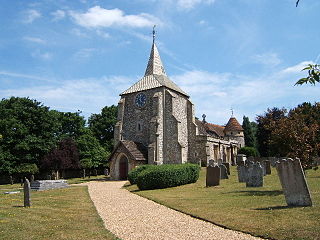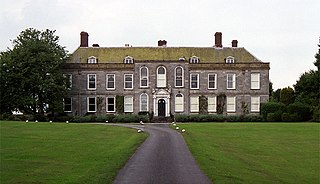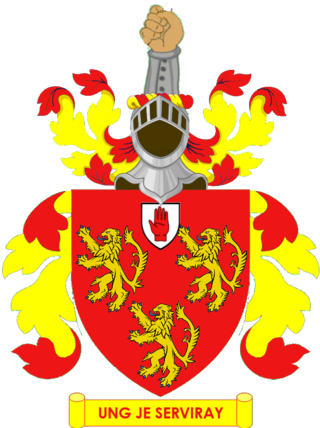Stydolph baronets, of Norbury (1660)

- Sir Richard Stydolph, 1st Baronet (c. 1630–1677)
The Stydolph Baronetcy, of Norbury in the County of Surrey, was a title in the Baronetage of England. It was created on 24 December 1660 for Richard Stydolph, subsequently High Sheriff of Surrey in 1667. The title became extinct on his death in 1677.
The family seat was Norbury Park, Surrey.


Duke of Westminster is a title in the Peerage of the United Kingdom. It was created by Queen Victoria in 1874 and bestowed upon Hugh Grosvenor, 3rd Marquess of Westminster. It is the most recent dukedom conferred on someone not related to the British royal family.

Earl of Egmont was a title in the Peerage of Ireland, created in 1733 for John Perceval, 1st Viscount Perceval. It became extinct with the death of the twelfth earl in 2011.

Earl of Onslow, of Onslow in the County of Shropshire and of Clandon Park in the County of Surrey is a title in the Peerage of the United Kingdom. It was created in 1801 for George Onslow, 4th Baron Onslow.

Earl of Norbury, in the County of Tipperary, is a title in the Peerage of Ireland. It was created in 1827, along with the title Viscount Glandine, of Glandine in the King's County, for the Irish politician and judge John Toler, 1st Baron Norbury, upon his retirement as Chief Justice of the Common Pleas in Ireland. The titles were created with special remainder to his second son, Hector, as his eldest son, Daniel, was then considered mentally unwell. Lord Norbury had already been created Baron Norbury, of Ballycrenode in the County of Tipperary, in the Peerage of Ireland in 1800, with remainder to the heirs male of his body. Moreover, his wife, Grace Toler, had been created Baroness Norwood, of Knockalton in the County of Tipperary, in the Peerage of Ireland in 1797, with remainder to the heirs male of her body. By the time Lord Norbury was raised to the Earldom, his wife had died and their eldest son had succeeded her as 2nd Baron Norwood. This son also succeeded Lord Norbury himself on his death in 1831 as 2nd Baron Norbury, whilst his younger brother Daniel succeeded to the viscountcy and earldom according to the special remainder. In 1832, the second Earl also succeeded his elder brother in the two baronies. He had already in 1825 assumed the additional surname of Graham by Royal licence.

Mickleham is a village in south east England, between the towns of Dorking and Leatherhead in Surrey. The civil parish covers 7.31 square kilometres and includes the hamlet of Fredley. The larger ecclesiastical parish includes the majority of the neighbouring village of Westhumble, from which Mickleham is separated by the River Mole.
There have been ten baronetcies created for persons with the surname Browne, six in the Baronetage of Great Britain, three in the Baronetage of Ireland and one in the Baronetage of Nova Scotia. Only one creation is extant as of 2010. Three of the creations were for members of the Browne family headed by the Viscount Montagu.

Sir Whitmore Acton, 4th Baronet was a British Member of Parliament.
The Newdigate baronetcy, of Arbury, Warwickshire, was created on 24 July 1677 in the Baronetage of England for Richard Newdigate of Arbury Hall. It became extinct on the death of the 5th Baronet on 2 December 1806.

This is a list of Sheriffs of Derbyshire from 1567 until 1974 and High Sheriffs since.
The list of known High Sheriffs of Surrey extends back to 1066. At various times the High Sheriff of Surrey was also High Sheriff of Sussex.

Norbury Park is a swathe of mixed wooded and agricultural land associated with its Georgian manor house near Leatherhead and Dorking, Surrey, which appears in the Domesday Book of 1086. It occupies mostly prominent land reaching into a bend in the Mole in the parish of Mickleham.
Norbury Blue is an English blue cheese made in Surrey. It is entirely handmade and the only blue cheese made in the South of England with milk from a closed herd of Friesian cows, fed on GM-free fodder. The cheese was made at the Dairy at Norbury Park Farm until 2018, when production moved to Sherbourne Farm at Albury.
This is a list of the sheriffs and high sheriffs of Staffordshire.

The FitzHerbert baronetcy, of Tissington in the County of Derby, is a title in the Baronetage of Great Britain. It was created on 22 January 1784 for William FitzHerbert, of Tissington Hall, Derbyshire.
There have been four baronetcies created for people with the surname Parsons, two in the Baronetage of Ireland, one in the Baronetage of England and one in the Baronetage of the United Kingdom. One creation is still extant as of 2008.

Sir John Acland, 1st Baronet of Acland in the parish of Landkey and of Columb John in Devon, England, was a Royalist commander in the Civil War, during the early part of which he maintained a garrison for the king on his estate of Columb John. He was created a baronet in 1644 for his support, but the letters patent were lost or never finalised and the dignity was not confirmed until 1677/8, long after his death. He compounded with Parliament for his estate in 1646 and died the following year.
The Standish Baronetcy, of Duxbury in the County of Lancaster, was a title in the Baronetage of England. It was created on 8 February 1677 for Richard Standish, subsequently member of parliament for Wigan. The title became extinct on the death of the third baronet in 1812.
Events from the year 1677 in Ireland.

Henry Norbury of Hoddesdon and Little Berkhamsted in Hertfordshire, was an English soldier and nobleman who served as a Member of Parliament for Bedfordshire in 1454 and later again in 1454.

The Church of St Mary is an Anglican church in the village of Stoke d'Abernon, Surrey, in the Diocese of Guildford. The church, the oldest parts of which date from the 7th century, is a Grade I listed building.